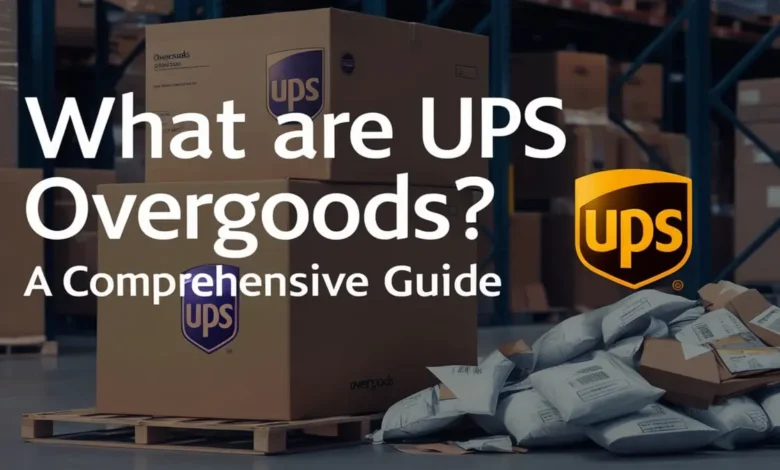What is UPS Over goods? A Comprehensive Guide

What is UPS Over goods? When it comes to shipping, especially with a global carrier like UPS, terms can sometimes get a little confusing. One term that might seem unclear to some is “UPS over goods.” If you’re involved in logistics, shipping, or e-commerce, understanding what UPS over goods are, and how they might affect your shipments, is essential. In this article, we’ll dive deep into the concept of UPS over goods, explain how they work, and explore their significance in the shipping world.
UPS over goods refers to items that are improperly processed, undeliverable, or left unclaimed during a shipping journey. These items often end up in UPS’s “over goods” system, a warehouse dedicated to handling goods that couldn’t be delivered as expected. While the term may sound technical, anyone involved in shipping must understand what happens to packages that encounter issues during transit.
In the following sections, we will break down the concept of UPS over goods in more detail, including how over goods are handled, what happens to them, and how you can avoid having your packages fall into this category.

Understanding What is UPS Over goods: What You Need to Know
At the core, UPS over goods are simply shipments that have encountered some sort of issue preventing their successful delivery. These problems can range from incorrect addresses, failed delivery attempts, or even damage to the product. For example, a package that cannot be delivered because the recipient has moved or an address is incorrect will be categorized as an overgood.
The over goods system helps UPS manage these items. Instead of these parcels simply being lost or discarded, UPS has a dedicated space where they store over goods until they can either be returned to the sender, redirected, or disposed of properly.
UPS has a process in place to deal with these over goods, ensuring that there is an orderly method of sorting, identifying, and resolving issues with undelivered or misplaced shipments. This system not only helps in keeping track of goods but also minimizes the loss of packages that could potentially be salvaged or returned to the sender.
Why Do Packages Become Over goods?
UPS over goods aren’t a rarity, and there are various reasons why packages end up in this category. A common cause is when a recipient isn’t available to accept the package, or the address provided is incorrect or incomplete. For example, if a package is being sent to a business, but the business is closed or the recipient is unavailable, the package might be considered undeliverable.
Another common issue arises with international shipping. Packages can become over goods when customs clearance isn’t completed on time, or if the recipient doesn’t pay the necessary import duties or taxes. Sometimes, shipments get caught up in logistics issues such as delays at sorting facilities or misrouted deliveries, resulting in the goods being undeliverable.
In some cases, packages can become over goods due to damage. If a package is compromised during transit, either from rough handling or weather-related issues, it may be marked as an overgood if it can’t be delivered in its current condition.

The Role of UPS Over goods Warehouse
Once a package is identified as an overgood, it is sent to UPS’s over goods warehouse. This warehouse acts as a holding area for items that have failed to be delivered. It’s an essential part of UPS’s logistics network, where undelivered goods are sorted and stored.
UPS handles over goods in a structured way. The goods are not simply abandoned. Instead, they are carefully processed and identified in the warehouse to determine the next best step. Depending on the circumstances, the over goods may either be returned to the sender, sent to a different address, or held for further investigation.
In many cases, customers are notified when their items have become over goods, especially if it’s a result of an incorrect address or a failed delivery attempt. This notification allows for a resolution, and the customer can take the necessary steps to ensure their package reaches them.
How UPS Manages Over goods
UPS has specific protocols for managing over goods, ensuring that items are dealt with in a timely and efficient manner. Once an overgood is identified, it is entered into the UPS tracking system. From there, it’s handled in one of several ways:
- Return to Sender: If the package is undeliverable due to an error on the sender’s end (for example, an incorrect address), UPS may return the package to the sender. In some cases, the sender is given a chance to correct the issue, such as providing a new address.
- Customer Notification: In cases where the recipient’s address is incorrect, or they aren’t available to accept the package, UPS will often notify the customer. This allows them to update their information or request re-delivery.
- Undeliverable International Shipments: For international shipments, over goods may be subject to customs procedures or returned if they can’t clear customs.
- Disposal: In rare instances, overgoods are unclaimed or damaged beyond repair and must be disposed of or liquidated.
The key takeaway here is that UPS handles over goods with a high degree of care. These items are not left forgotten; rather, they are processed and sorted in a way that ensures their status is addressed appropriately.
Preventing Your Shipments from Becoming Over goods
One of the best ways to ensure your shipments don’t end up as over goods is to be diligent about the details. Whether you’re shipping as a business or an individual, taking the necessary precautions can prevent these issues from arising.
The first step is to make sure your shipping addresses are correct. Double-check the recipient’s details, including street addresses, postal codes, and contact information. Even a small mistake can result in a delivery failure and cause your package to become an overgood.
Additionally, if you are sending a package internationally, ensure that all customs requirements are met. This includes making sure that any duties, taxes, or other fees are paid, and that all customs documentation is in order.
UPS also offers tools that can help with tracking and managing deliveries. By setting up delivery alerts or using services like UPS My Choice, you can stay informed about the status of your shipments and avoid surprises.
What Happens to Over goods?
Once an overgood is identified, what happens to it? The final outcome depends on several factors, including the reason the package couldn’t be delivered and the condition it is in. If the issue can be resolved – such as providing a new address or confirming delivery details – the package may be returned to the sender or re-delivered to the recipient.
However, if the overgood is deemed unresolvable or is damaged beyond repair, UPS might dispose of it. In some cases, they may offer items for liquidation, where they are sold off at a discount. This is often a final resort after all other options have been exhausted.
UPS also has a program for unclaimed or unprocessed over goods, where these items can be liquidated through various channels, including auctions or special sales. This is an opportunity for individuals or businesses to purchase items that have been unclaimed or left in limbo.
UPS Over goods Liquidation and Auctions
One interesting aspect of UPS over goods is the possibility of liquidation. This is when over goods are sold off at a discounted price, often through auctions. Many companies or individuals who find themselves in need of discounted products turn to liquidation sales for potential bargains.
UPS has a system in place that facilitates this process. Goods that have become over goods, especially those that remain unclaimed or are deemed unfit for delivery, may be sold in bulk to liquidation companies. These companies then resell the products, offering consumers a chance to purchase goods at a lower cost.
While liquidation may sound appealing, it’s important to keep in mind that these items are typically sold “as is.” This means that there could be potential issues with the products, such as damages, missing parts, or incomplete packaging. Therefore, buyers need to exercise caution when considering purchasing UPS over goods through these liquidation channels.
Conclusion
UPS over goods plays a crucial role in the logistics and shipping process, especially when it comes to dealing with undeliverable items. Whether it’s due to address errors, failed delivery attempts, or damage during transit, UPS has systems in place to handle these goods efficiently and responsibly.
For businesses or individuals involved in shipping, understanding UPS over goods can help you prevent your own shipments from falling into this category. By ensuring accurate addresses, paying attention to customs requirements, and monitoring delivery statuses, you can avoid the common pitfalls that lead to over goods.
UPS’s over-good management system not only keeps track of undelivered items but also offers opportunities for liquidation or return, giving products a second chance to reach their final destination. So, whether you’re sending or receiving packages, knowing about UPS over goods is an essential part of the shipping world.





